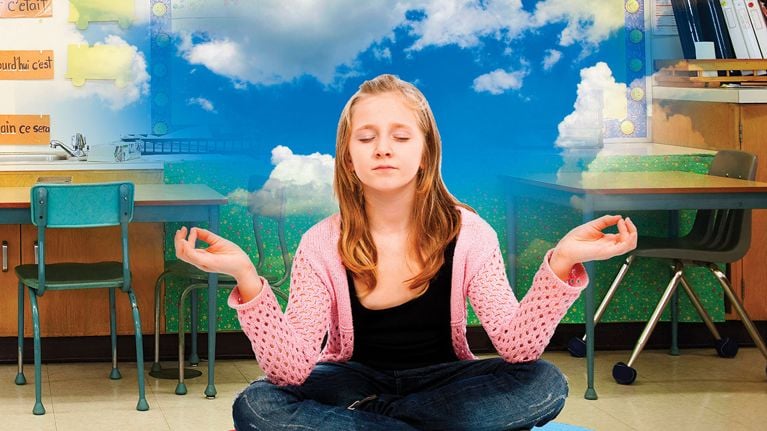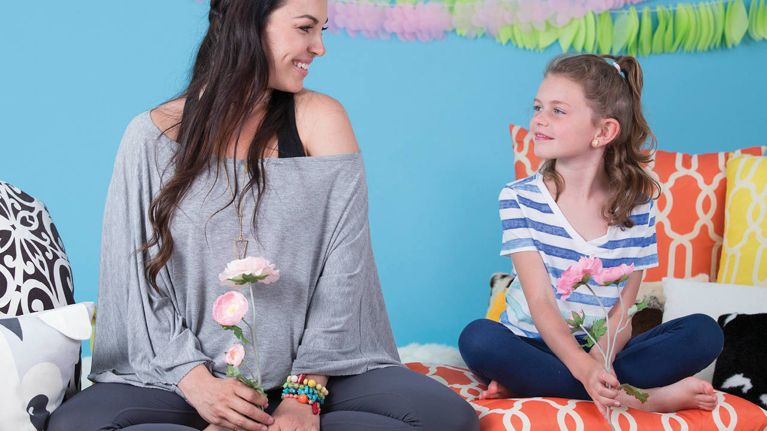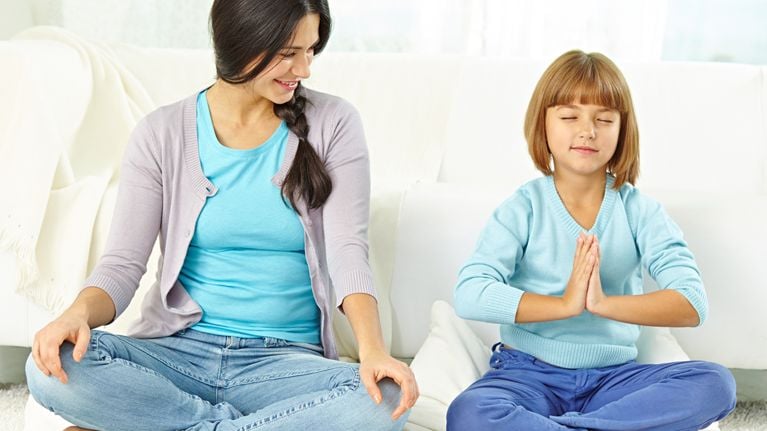Mindfulness for kids: Learning emotional regulation in school
Lessons in mindfulness are creeping into elementary classrooms, and proponents insist it's making for happier, more focused students.

Background: Corbis. Girl and clouds: Shutterstock
As morning recess ends at Bracebridge Public School, a kindergarten to grade eight school in Ontario’s cottage country, the grade fours and fives of room 128 shuffle upstairs to their class, everyone talking in outdoor voices. Most are slow to settle. Back in their homeroom, a boy in a black-and-white hoodie stops at the aptly named Mindfulness Corner set up beside the coat rack.
The spot, outfitted with a table, gives students a place to go if they need a minute to calm down. A poster encourages kids to “Just be in the moment,” and a Post-it reads, “Breathe and smile.” The boy leans over the table and, with his hands on his tummy, takes three deep breaths before quietly completing a finger maze.
Laura Dursley, the school’s new vice-principal, has invited me to sit in on her weekly 11:10 a.m. mindfulness lesson with this class. Alongside learning reading comprehension, mastering decimals and studying the medieval period, these students are getting an education in emotions.
Bracebridge PS is one of dozens in the Trillium Lakelands District School Board that are integrating mindfulness in the curriculum as a tool to decrease student anxiety and stress and to increase concentration, attention span, self-regulation, compassion and self-esteem.
Mindfulness is a centuries-old concept rooted in meditation. It was widely introduced in the late 1970s by Jon Kabat-Zinn, an American doctor who developed mindfulness classes for patients dealing with all sorts of physical and mental ailments, and it has become increasingly popular over the past 20 years. It’s all about paying attention to your breathing and focusing on what’s happening at the moment in a non-judgmental way—which is easier said than done.
Doctors prescribe it to patients suffering from everything from cancer and migraines to anxiety, depression and adult ADHD, and major corporations have bought in, too (Google offers regular sessions to employees). It’s now creeping into elementary school classrooms in the United States and Canada, particularly in BC and Ontario.
Regulating emotions
Nine- and 10-year-olds often have a tough time settling after transitions, which makes Dursley’s post-morning-recess mindfulness lesson perfectly timed to focus and calm them for the rest of the day. Dursley instructs the students to take a seat around her, and then she pulls a singing bowl—a standing bell used in meditation, relaxation and music—out of her prop basket and asks the class what they’re to do when they hear the chime.
“We close our eyes, and when we don’t hear it anymore, we open them,” says one girl. “We think about our breathing,” another replies. When Dursley strikes the bowl, the kids close their eyes almost en masse. She instructs the quiet group to feel the air rush in and out through their nose and to notice the rise and fall of their belly with each inhalation and exhalation.
When the ringing stops, everyone’s eyes are open. “How was that?” she asks. A student shared that his mind had wandered away from his breathing. “Our minds are busy places and even busier when we get upset or frustrated,” Dursely says, nodding reassuringly.
“Do you know the word ‘anchor’? Remember that your breath is like an anchor that keeps you in the moment,” she says as she pulls out a two-litre pop bottle filled with glitter in pink water. “The sparkles are what your minds look like when there’s lots going on in your head or when you’re angry,” she says, shaking the bottle. “When you focus on breathing instead of reacting, you’ll see the sparkles sink, and the water becomes clearer. This is what our minds look like when we concentrate on our breathing. When we’re calm it helps us make clear, wise decisions.”
For the next half-hour, the students practise breathing exercises. They end the session with Dursley asking which mindfulness activity they most enjoy. Their answers are pretty telling. “I could feel my breath more and calmed down when I looked at the sparkles in the bottle,” says one girl. A boy responds: “When I return from recess, I relax when I hear the singing bowl.”

Promising mindfulness research
Many educators believe it’s about time mindfulness has made its way into the classroom. If the Toronto District School Board’s recent survey on student mental health is any indication, it’s long overdue.
According to the board’s 2011–12 Student & Parent Census, released in June 2013, almost a third of the grade seven and eight students surveyed said they are concerned about relationship issues such as making friends and fitting in; nearly half worry about family matters all the time or often; the majority have anxiety about schoolwork all the time or often; 59 percent worry about their future; and 11 percent feel unable to overcome difficulties all the time or often.
Introducing mindfulness practice in schools has been the source of some controversy. Some parents and educators have questioned whether it’s too close to its Buddhist roots to be appropriate in secular schools, and others question whether it’s the best use of classroom time. But the evidence for its emotional and behavioural benefits is mounting.
Early research suggests mindfulness can help alleviate student anxiety and improve learning. A 2009 study published in Advances in School Mental Health Promotion found students learning about mindfulness reported being more relaxed and calm following their training.
Another study, out of the University of California, Los Angeles, found that kids in grades two and three who learned mindfulness techniques for an hour a week for eight weeks could better regulate their behaviour and showed improvement in executive functions, such as paying attention, making decisions and focusing without getting distracted.
One of the big players in mindfulness education is MindUP, a program founded by actress Goldie Hawn and developed with a team of neuroscientists, cognitive psychologists and educators. MindUP offers in-school training for educators and resource guides for pre-kindergarten to grade eight. University of British Columbia researchers found the program had a positive effect on students’ emotional control, academics, empathy, stress regulation and attentiveness.
Seeing real-life benefits
Parents and educators alike are seeing the positive impact of mindfulness lessons.
Sandra Northmore, whose daughter, Morgan, is in grade seven at Bracebridge PS, was introduced to mindfulness ten years ago while dealing with her mother’s cancer diagnosis. She didn’t know her daughter was learning the practice in school until they renovated their home in 2012. “It was a very stressful time. Morgan sat my husband and I down and asked us to close our eyes and she walked us through a breathing meditation. It was a huge surprise and created calm for the whole family,” she remembers.
After a few years of practising mindfulness at school, it’s become Morgan’s default for healthfully dealing with stress outside school, too. “When she’s busy, she centres herself by closing her eyes and taking deep breaths.”
What’s more, says Northmore, mindfulness education has far-reaching benefits. “This is a life skill that can support their years of education, their home life and their future as an adult. It can create a more thoughtful community at school, reducing unkind behaviours and enhancing a positive learning experience.”
For Morgan, who is two years away from the pressures of high school, the lessons have been invaluable. “School can be demanding, and it creates calm and balance to better get through the day,” she says.
Educators at Bracebridge PS are seeing positive results, says Dursley. There’s less bullying and conflict in class, and when there is, students are not as quick to lash out in mean-spirited ways. Students are more thoughtful and empathetic and can better articulate and regulate their emotions. Overall, there’s a happier atmosphere in the hallways and playgrounds.
The exercises the school has implemented—lessons, classroom mindfulness corners and a mindful moment during morning announcements that involves standing in mountain pose as chimes ring—is one reason for a greater sense of compassion in the school. “The kids are now better able to remember strategies they can use to keep calm when they are anxious, angry or upset,” she says.

Mindfulness from day one
At W.T. Townshend Public School in Kitchener, Ont., kindergarten teacher Jennifer Evans also uses mindfulness tools in her classroom. “We have found that more and more elementary students are coming to school with some form of anxiety, and this seemed like a way we could help them control that worrying,” she says.
To complement a school-wide mindful moment each morning, Evans uses a “calm down” beanbag chair, squishy balls, deep breaths and books—such as Peaceful Piggy Meditation and Mindful Monkey, Happy Panda—with her students. “Some of the children will go to the beanbag chair to calm their bodies and refocus their energies without us even prompting them,” she says.
Health and wellness teacher Karen Snider, who spearheaded the practice at W.T. Townshend, tells her students—from kindergarten to grade six—that mindfulness lets us notice how we’re feeling, which can help us calm down when “big emotions” occur. “It’s an exercise for our brain. Like people lift weights to get stronger, we can strengthen our brain by taking time each day to practise mindfulness,” she says.
Snider uses the MindUP curriculum and lessons from the Inner Kids and Mindful Schools programs. The response from colleagues has been so positive that she’s running lunch-and-learn sessions for teachers to work on their practice. “They say it starts the day on a calmer note and lets the kids give themselves some quiet grounding breaths to ease into class,” she says. “We’ve also had supportive feedback from parents—many have expressed gratitude for offering this kind of social and emotional learning.”
Mom Stacey Arnold has seen big changes in her son, Blake, 7, and daughter, Paige, 4, who attend W.T. Townshend. Paige, who’s in JK, is already well-versed in the techniques. “She often describes things as green (good) or red (bad) choices and discusses how each affects others. For example, she’ll tell her brother, ‘Blake, please stop pushing me. That is a red choice, and it hurts me. Make a green choice and say you’re sorry,’” Arnold says. “Before mindfulness, she would just push him back, and it would turn into a fight between them.”
Snider’s passion for mindfulness has made it a significant part of the health curriculum at the school. “The idea of teaching kids a practice that can help them know themselves better, be more resilient and learn how to recognize their emotions was something the entire staff wanted to bring into the classroom,” she says. “And what better place to learn it and turn it into a habit than in elementary school? We can give a generation of kids the skill set they need to help them deal with all that life throws at them.”
A version of this article was featured in our January 2015 issue, with the headline “Mind over math?,” p.43.
Weekly Newsletter
Keep up with your baby's development, get the latest parenting content and receive special offers from our partners